Fermented vegetables are not only absolutely delicious and healthy food for our microbiome due to their probiotic ingredients, they are also often a feast for the eyes and beautiful to look at. My ferments may also please the ears and sound good - hello, Berkeley Haze, fermented Jerusalem artichoke with purple carrots.
The combination of Jerusalem artichoke – also known as sunchoke – and dark purple carrot with juniper and fresh dill is simply the ultimate experience. In terms of taste, health benefits (Jerusalem artichoke has extremely high levels of prebiotic inulin) - and above all in terms of color! Every day the vegetables in the jar look different than before. It's like watching the sun set for days on end.
Speaking of sunsets - the inspiration for this ferment originates in my second homeland California. When homesickness grabs me and I miss my friends and family, I sometimes surf to the page from the cultured pickle shop in Berkeley, CA. How I would love to take a lunch break there now and then. Since that's not possible, I just let myself be inspired by their offers. For example Purple Carrots & Sunchokes with Dill and Juniper.
I' m telling you: It's a revelation. No kidding. Ferment this. Now.
And because this ferment is extremely popular not only with me, but with everybody, I produce rough masses of it during the season (autumn - winter). By the way, the fresh dill is essential for the taste, don't leave it out. Since it is not always available in winter, you can grow your own at home.
INGREDIENTS
- 380 gr. purple carrots, e.g. Purple Haze, Lila Luder, Deep Purple, ... * (50%)
- 380 gr. Jerusalem artichoke (50%)
- 10 juniper berries
- 1 bunch of fresh dill
- 500 ml water
- 10 gr. salt
These ingredients fit into a 1 liter swing top jar. If I use a 2 liter vessel, about 500 gr. of each vegetable fit in, I increase the juniper berries to 25 and add 700 ml of brine. A bunch of dill is a bunch of dill, more does not make a difference in taste.
* The darkest, solid colored carrots have the most beautiful color result. If you take carrots that have a yellow core, the ferment will be pink rather than purple. This makes only a very subtle difference in taste, so you don't have to sample-slaughter carrots when you buy your veggies. I have also used plain carrots - but then I put a small slice of beet in the bottom of the glass to get the pink color. Without pink or purple, it's not Berkeley Haze 😋
PREPARATION
First, prepare the brine so that the salt has enough time to dissolve. To do this, mix the salt with the water.
Cleanly brush the Jerusalem artichoke roots and either also brush or peel the carrots. I personally do not like carrot skin and therefore remove it. Try it out the way you like it best. There are good micro-organisms on the skin that help with fermentation - so, it's only bad if the mouthfeel is affected.
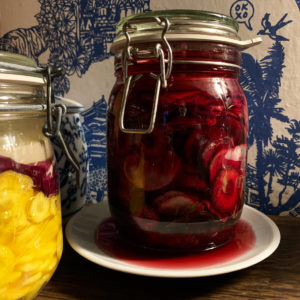
Cut both vegetables into very tender slices. This is much easier with the vegetable slicer than by hand.
Place the juniper berries at the bottom of the glass, then drape the dill over them. Alternately layer the Jerusalem artichoke and the carrots and top with one or more fermentation weights . Make sure that you leave at least 3-4 cm room to the top, otherwise your ferment will get wet feet. This happens when there are enough carbohydrates (and in the case of Jerusalem artichokes, also a lot of inulin) - and you fill the glass too high.
Top up with salt water and allow to ferment for at least eight weeks.
Do not forget to admire the fascinating color development in the first few days ❤️

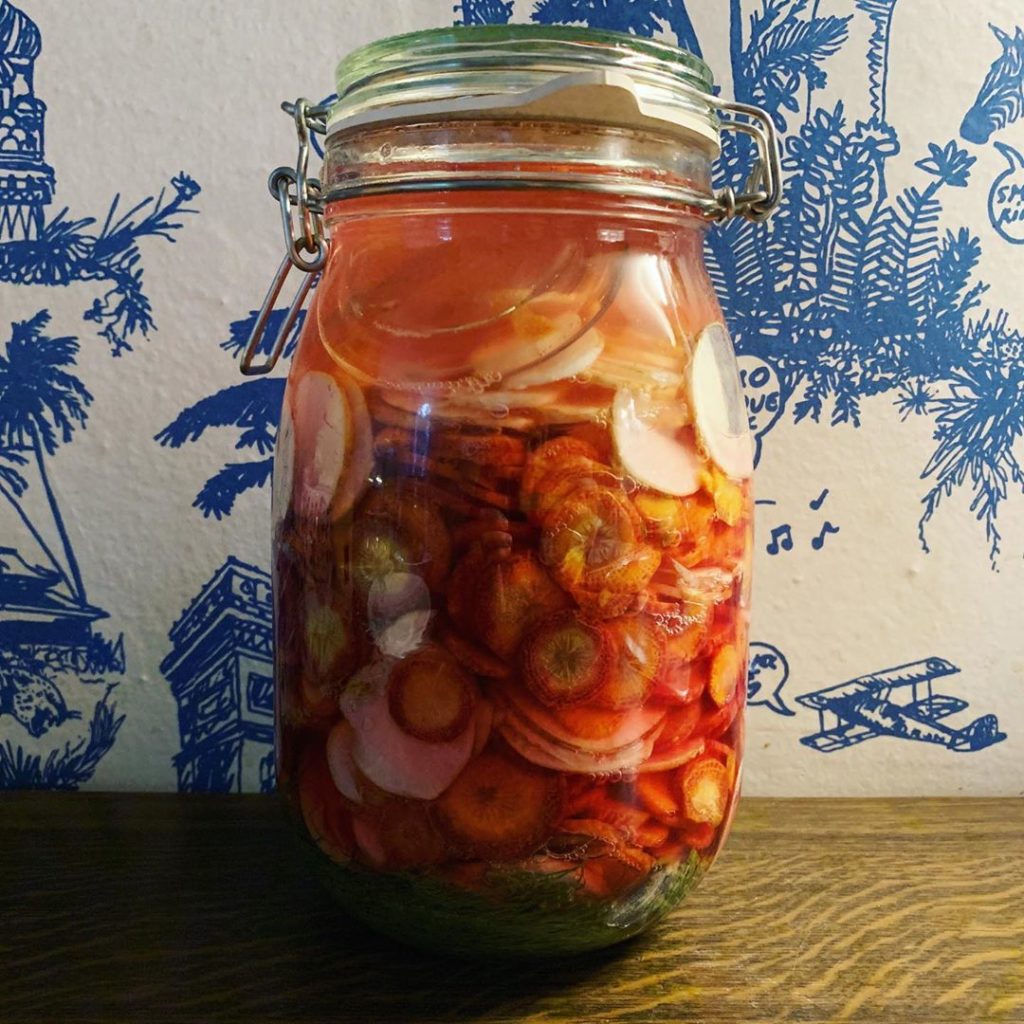
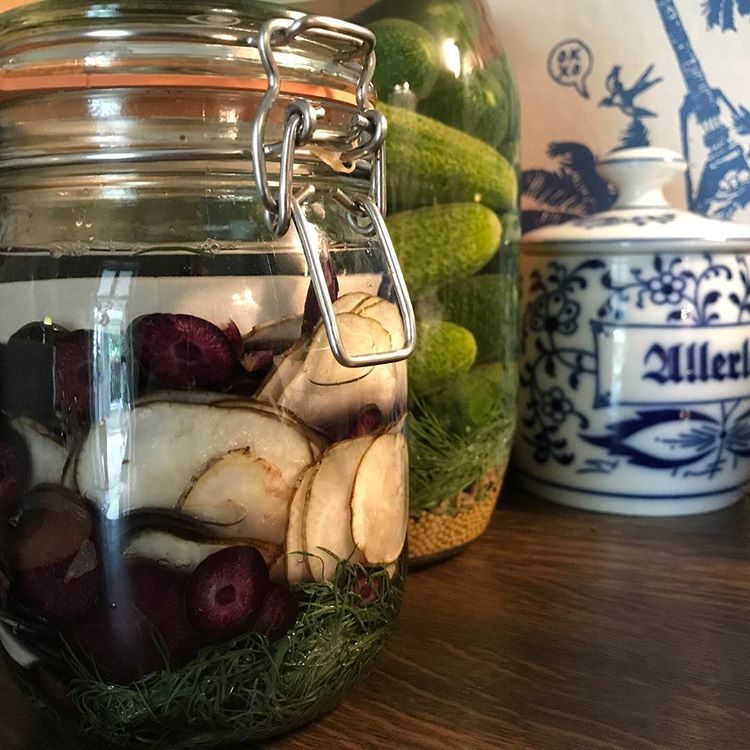
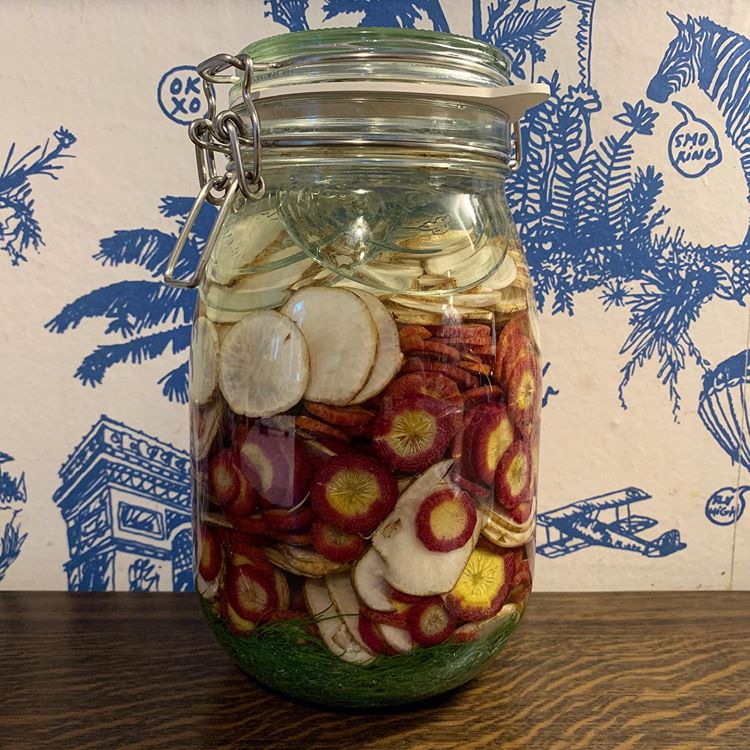
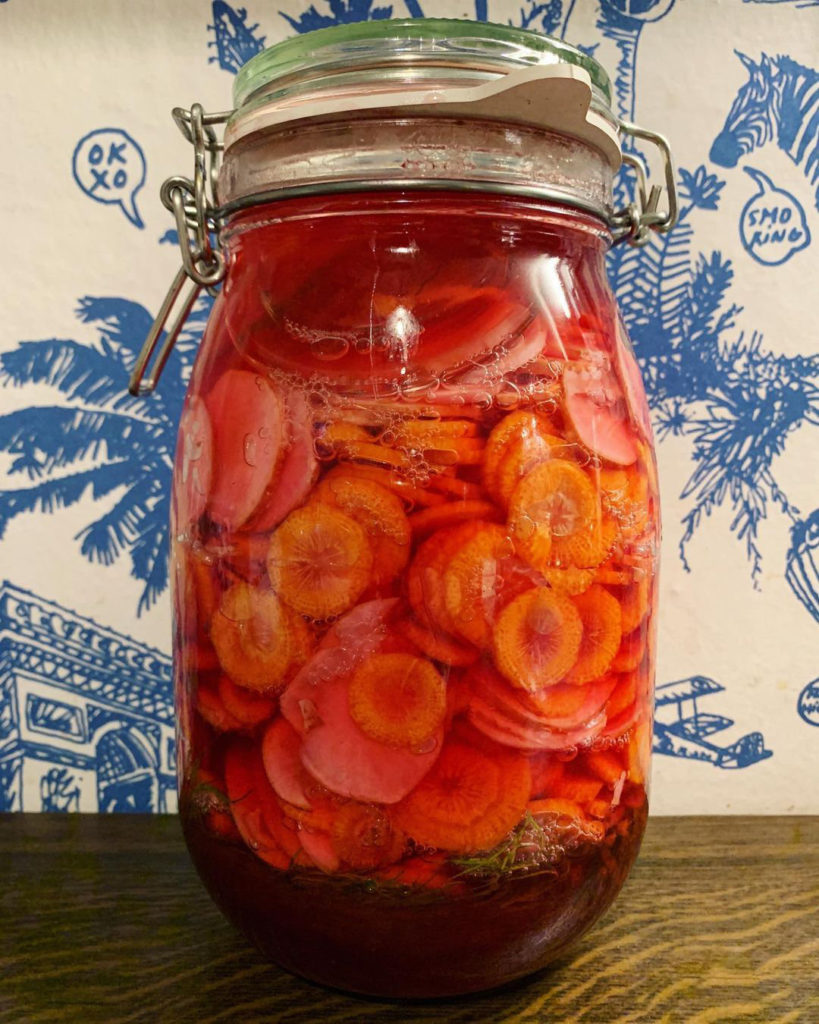
As a solo ferment, Jerusalem artichoke unfortunately never turned out well for me, it always became slimy. This not untypical slime is due to the high inulin content of the root and is called dextran.
Have you ever fermented Jerusalem artichokes successfully?


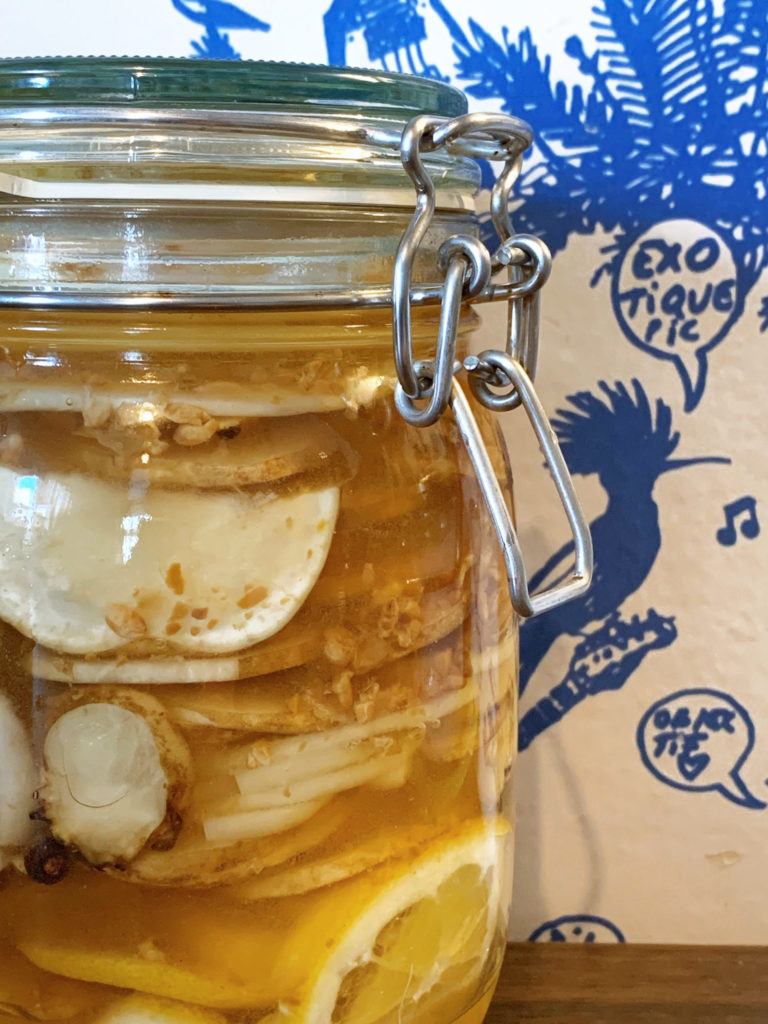


oh yes !!
Jerusalem artichoke is also my favorite !!!
I mix some red onion, some sweet bell pepper, grated turmeric (so it turns yellow) and yakon pieces to it; tastes fantastic even after a year at about 10-16 °C !!!!
Hej Susanne,
I also love the combination with turmeric a lot! And yes, it's great that fermentation is preservation and you can still nibble crunchy vegetables even after months.
Best regards,
Katsu
Hallo liebe Katsu,
war eine ganze Weile verschwunden.
Imker im Raum Berlin haben dieses Jahr mehr als genug zu tun.
Nächste Woche die 2. Ernte. 🙈. Mich graust es, aber dankbar jetzt schon.
Tja und für meine Damen hab ich natürlich reichlich kleine Sondersachen gepflanzt.
Wie Lavendel in Massen.
Aber auch Tompinapur. Aber in Butten, weil…….sonst ist der ganze Garten voll.
In Blüte für meine Damen und im Herbst dann Knollenernte für mich. Ca. die Hälfte.
Der Rest ist als Basis für nächstes Jahr.
Und dann lese ich. Tompinapur mit Möhren und *HONIG*
Na das Ferment wird ganz bestimmt bei mir zum Einsatz kommen.
Aber Kaffeelikeur, Honigtomaten auch.
Ingwer/Kurkuma ist bei mir Bestandteil für meine Apimedizin.
Ansatz mit Fichtennadelfrischgrün und vielen frischen Gewürzen wie Thymian, Salbei und Co. Und natürlich Ingwer und Kurkuma.
Dauert aber bis Anfang Dezember bis es fertig ist. Da mach ich dann zum Schluss noch Propolis ran.
Aber Achtung: wer eine Bienenallergie hat sollte auf Propolis verzichten.
Jedenfalls ein Hustenmittel ohne Chemie und Co.
Liebe Grüße aus Berlin
Die Imkerin mit bee-soul
Hej Petra, schön, dass du wieder da bist. Und dann auch noch mit so vielen tollen Projekten!
Hallo Susanne,
ich habe Topinambur in Salzlake mit Wacholderbeeren eingelegt. Nach anderthalb Wochen aus dem Kühlschrank probeweise geöffnet und probiert. Es schäumte sehr stark und roch auch nicht besonders gut. Ist das normal?
Liebe Angelika,
ich weiss nicht, ob Susanne eine Benachrichtigung bekommt. Ich kann Dir dazu sagen, dass ich Topinambur in ganz schlicht auch nicht geniesse. Die Kombi mit lila Wurzeln, oder mein anderes Rezept mit Miso und Zitrone, jedoch, finde ich immer ganz fabelhaft.
In den Kühlschrank müssen die Fermente auch erst nach einer wärmeren Anfangsphase.
Ich hoffe, das hilft Dir weiter?
Viel Freude mit Deinen Fermenten,
Katsu
Ich habe dieses Rezept mit normalen Möhren hergestellt. Dabei bin ich zum ersten mal deiner Empfehlung gefolgt darüber Buch zu führen. 2 Monate nach dem Ansetzen habe ich es geöffnet. Es hatte keine Flüssigkeit, das, was sich neben dem Gewicht bräunlich verfärbte habe ich abgenommen und es gegessen. Mochte ich gerne. Was mich aber wunderte: Die Möhren und Topinambur waren weich, als hätte ich sie gekocht. Hast du eine Ahnung, woher das kommt?
Wir werden es auf jeden Fall wieder machen, die Bekömmlichkeit des Topi verbessert sich wesentlich 🙂
Liebe Efia,
das ist eine sehr gute Frage! Dass Gemüse beim Fermentieren weicher wird, und wie man das steuern kann, habe ich ja in diesem Artikel schon aufgeschrieben (https://fermentation.love/fermentation/fermentation-faq/#warum_werden_fermentierte_karotten_oder_gurken_so_weich). Warum es überhaupt weich wird, jedoch noch nicht.
Gemüse ist aus komplexen Kohlehydraten aufgebaut. Kohlehydrate? Da war doch was… was passiert nochmal bei der Laktofermentation? Richtig: Die Bakterien transformieren Kohlehydrate zu Milchsäure. Die Struktur der Kohlehydrate lockert sich also und das Gemüse wird weicher.
Ich wünsche Dir weiter gutes Gelingen und freue mich über so tolle Fragen.
Best regards,
Katsu
Hallo Katsu, Du schreibst zum Topinambur-Rüben-Rezept, dass es 8 Wochen fermentieren soll, aber nicht, ab wann es gekühlt werden soll. Sorry, ich fange erst an, deshalb die doofe Frage….Nach ? Wochen muss es in den Kühlschrank? Bei mir steht es schon 14 Tage bei 20-22 Grad… ups, ist das falsch?
LG, Karin
Hej Karin,
ab jetzt könntest Du es kühler stellen, zum Beispiel in ein Regal im Flur oder so. In den Kühlschrank muss es erst, wenn es geöffnet wurde. Oder einen Tag vor dem Öffnen – ich habe die Erfahrung gemacht, dass die meisten Fermente durch eine kalte Nacht geschmacklich profitieren.
Gutes Gelingen!
Katsu
Hallo Katsu, würde das auch gut mit Roten Rüben passen? Die hätte ich nämlich da und massenhaft Topinambur, den ich gerne haltbar und bekömmlicher machen würde – was ich mir von Fermentation erhoffen würde.
Danke Dir und LG, Eva
Hej Eva, ich weiss nicht, was rote Rüben sind, aber probier es aus. Gutes Gelingen!